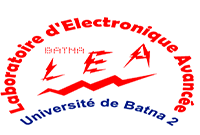Iron thin films were deposited on glass substrates using RF magnetron sputtering and their optimal deposition conditions were determined. The structure properties were analyzed using x-ray diffraction (XRD) and their magnetic hysteresis loops were obtained by Vibrating Sample Magnetometer (VSM) at room temperature. In this situation, the magnetic field is either parallel or perpendicular to the substrate plane. The main contribution of this work is to characterize the thin layers and present a mathematical model that can get best fit of the characteristics B(H). By using Preisach model, good agreement was obtained between theoretical and experimental results in both cases.
Silicon oxide (SiO2) is a good dielectric material in metal-oxide-semiconductor (MOS) structures. The improved SiO2 quality requires adequate study of doping diffusion in this structure to maintain the absence of the different impurities in the interface Poylsilicon/SiO2. For this we studied a theoretical model of boron diffusion before and after thermal annealing in a highly-doped polysilicon films. The model takes into account the distribution of vacancy mechanism by associating parameters and effects related to high concentrations. Based on the literature the model is solved using the engineering software tool MATLAB, following a well-defined algorithm. The model is validated with the help of simulation results obtained from Silvaco.
In this study, single crystal Ge layers have been deposited by molecular beam epitaxy on PSi substrate, with different thicknesses (40 nm and 80 nm) at the growth temperature of 400°C. Raman and Atomic force microscopy (AFM) have been applied for investigation of photoluminescence, structural and morphological properties of the Ge on PSi layers. The results show a stronger Raman intensity of PSi due to change of its optical constant. Similarly the Si/Ge/PSi sample shows a peak at 399 cm-1 but with lower intensity compared with that of PSi probably due to the Si emission partially covered by the Ge inside the pores. Besides that a sharp Raman peak at 298 cm-1 is observed which reflects Raman active transverse optical mode of the introduced Ge which indicates the growth of Ge with good crystallinity. AFM characterization shows the rough silicon surface which can be regarded as a condensation point for small skeleton clusters to form, with different size of pores. These changes are highly responsible for its photoluminescence in the red wavelength range. This study explores the applicability of prepared Ge/PSi layers for its various applications in advanced optoelectronics field and silicon-on-insulator applications.
Single crystal Silicon (Si) layers have been deposited by molecular beam epitaxy on double-layer porous silicon (PSi). We investigate the structure and morphology of double-layer PSi as fabricated and after annealing at high temperature. We show that a top thin layer with a low porosity is used as a seed layer for epitaxial growth. While, the underlying higher porosity layer is used as an easily detectable etch stop layer. The morphology and structure of epitaxial Si layer grown on the double-layer PSi are investigated by transmission electron microscopy and high resolution X-ray diffraction. The results show that, an epitaxial Si layer with a low defect density can be grown. Epitaxial growth of thin crystalline layers on double-layer PSi can provide opportunities for silicon-on-insulator applications and Si-based solar cells provided that the epitaxial layer has a sufficient crystallographic quality
In this paper, a new junctionless optical controlled field effect transistor (JL-OCFET) is proposed to improve the device performance as well as achieving low power consumption. An overall optical and electrical performances comparison of the proposed junctionless design and the conventional inversion mode structure (IM-OCFET) has been developed numerically, to assess the optical modulation behavior of the OCFET for low power optical interconnections applications. It is found that, the proposed design demonstrates excellent capability in decreasing the phototransistor power consumption for inter-chip optical communication application. Moreover, the proposed device offers superior sensitivity and ION/IOFF ratio, in addition to lower signal to noise ratio as compared to the conventional IM-OCFET structure. The obtained results indicate the crucial role of the junctionless (JL) design in enhancing the phototransistor performance and reducing the total power dissipation. Such a very sensitive OCFET can be very promising in the future low power optical receiver less compatible to CMOS modern technology for high-quality interchips data communication applications.
The use of uniformly doped channel, source and drain regions presents the well-known problem of the high series resistance associated to the extensions, which degrades the electrical performance of the nanoscale multi-gate junctionless MOSFETs. Therefore, new designs and accurate investigation of nanoscale double gate junctionless (DGJ) MOSFET including the defects at the interface Si/SiO2 are required for the comprehension of the fundamentals of such device behavior against the ageing phenomenon. Based on 2D numerical investigation of a nanoscale DGJ MOSFET, in the present work a numerical study for I-V and small signal characteristics, by including both the highly doped extension regions and the interfacial defects, is presented. The investigated design, which is a technologically feasible technique by introducing only one ion implantation step, provides a good solution to improve the device immunity against the interfacial defects under critical conditions, where the channel length is taken equals to 10 nm. In this context, I-V, analog and linearity characteristics are investigated by an appropriate 2-D numerical modeling, where the obtained results are compared with those of the conventional DGJ MOSFETs. (© 2016 WILEY-VCH Verlag GmbH & Co. KGaA, Weinheim)
